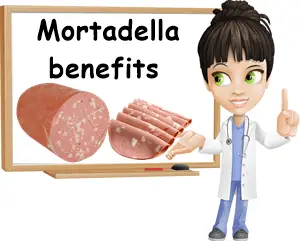Mortadella or mortadella meat is an Italian delicacy made exclusively from pork meat with chunks of pork neck fat. It’s essentially a fancy bologna sausage, but a lot higher-quality and much more exquisite-tasting. Mortadella has PGI status, meaning Protected Geographical Indication, acknowledging it as a traditional Italian specialty of the utmost quality from the Emilia-Romagna region.
The proud Italian luncheon meat is high in protein and fat and an important source of vitamins B1, B2, B3, B6 and B12, choline, iron, phosphorus, potassium, selenium, sodium and zinc.
Despite its nutritional value being dimmed by a high salt content and the presence of nitrites and nitrates, mortadella provides a range of valuable benefits, promoting skin, hair, nails and teeth health, contributing to better mood and higher energy levels and supporting red blood cell production and muscle repair.
What is mortadella?
Mortadella is an Italian charcuterie delicacy, a type of deli meat or luncheon meat similar to the more common bologna sausage or baloney. It is made of finely ground pork meat with visible pieces of pork neck fat, and seasoned with black pepper. Before pepper was imported to Europe, mortadella would be flavored with myrtle berries, which were a popular choice of spice pre-pepper times.
That would mean mortadella has a long history, the first mortadella-like preparations dating back to Ancient Rome. The first written recipe for mortadella dates back to the 1600s – except for the choice of spices and seasoning and the higher fat content, the first recorded mortadella recipe is pretty much modern-day mortadella.

What is mortadella meat made of?
Classic mortadella is made of the highest-quality pork meat with at least 15% pork fat, usually pork neck fat. Standards dictate mortadella have visible pieces of pork fat of different sizes, disposed in an irregular pattern in the meat block. In accordance with the original recipe, salt, myrtle berries and ground or whole black pepper are used to season mortadella. Several other spices and ingredients are commonly added, including garlic, pistachios, chili peppers, cardamon, nutmeg, cloves, coriander, caraway, cinnamon, anise, star anise and more.
While mortadella variations exist, for a product to be called mortadella, it has to be made exclusively from pork meat and lard. If it’s made from beef or veal or some other type of meat, or even if it’s made from pork and some other type of meat, it’s not real mortadella, but rather baloney, also called a Bologna sausage in the US, or parizer or pariser in Central, Southern and Eastern Europe.
Also, luncheon meats that resemble mortadella in appearance, and sometimes also taste, such as parizer or baloney, are typically made from leftovers or scraps of pork or other meats, vs mortadella which is made of the best pork meat and the best pork lard.
What does mortadella look like?
Mortadella is a large block of meat that can weigh anywhere from a few kilograms to a few dozens of kilograms. It’s round or sometimes oval and looks like a giant salami. Inside, mortadella is a vibrant pink with chunks of white pork fat (lard) disposed in an irregular pattern. The original recipes requires mortadella to contain at least 15% fat. Mortadella feels velvety to the touch and has a soft texture.

What does mortadella taste like?
Mortadella has a moderate, but delicate pork taste, it’s soft and has a fine, velvety texture. It tastes fatty, but not excessively so it doesn’t cause nausea. If I had to describe mortadella, I would say it tastes somewhat like prosciutto cotto, but slightly fattier or heavier and just a little less flavorful (because it’s not cured like prosciutto cotto). Those who are familiar with baloney and parizer say mortadella tastes similar, but vs bologna and parizer, it’s more delicate and exquisite. Mortadella with green olives or pistachios is a real treat.
Is mortadella a cooked or cured meat?
Mortadella is actually a cooked meat product. It tastes somewhat like prosciutto cotto, a great way to tell that it’s cooked, not cured. It is made exclusively from pork meat which is ground, then fat bits are added (lard) and the whole product is pressed and bagged in an inedible casing. The entire mortadella is then tied up with string to help it retain its round or oval, thick, salami shape and hung in a hot air drier to cook. It’s cooked for almost a day to several days, depending on how big it is.
Mortadella nutrition
Mortadella boasts excellent nutrition. The Italian delicacy is all pork meat and lard. The pink part, the pork meat, is a rich source of protein, fat, B vitamins, especially vitamins B1, B2, B3 and B6, and zinc. It’s also a good source of vitamin B12, iron, phosphorus and potassium. The fat chunks in mortadella are essentially lard and thus 100% fat, almost 40% of which is saturated. But the fat chunks are also a great source of choline.
The energetic value of mortadella varies between 250-310 kilocalories per 100 g, which is actually not as high as one would expect considering mortadella is studded with chunks of actual pork fat.
Mortadella nutrition facts per 100 g
- Energetic value: 310 kilocalories
- Protein: 15-20 g
- Fat: 25 g of which 9.5 g saturated fat, 11+ g monounsaturated, 3+ g polyunsaturated
- Cholesterol: 56 mg (but can be higher)
- Carbohydrates: 3 g
- Vitamin B1: 0.12 mg (about 10% of daily requirements, RDI)
- Vitamin B2: 0.153 mg (about 11.5% of daily requirements, RDI)
- Vitamin B3: 2.673 mg (about 16.5% of RDI for men and 19% of RDI for women)
- Vitamin B6: 0.13 mg (about 10% of RDI)
- Vitamin B9: 3 micrograms
- Vitamin B12: 1.48 micrograms (roughly 60% of RDI)
- Vitamin E: 0.22 mg
- Vitamin K: 1.6 micrograms
- Choline: 72 mg (13% of RDI for men and 16.9% RDI for women)
- Calcium: 18 mg
- Copper: 0.06 mg
- Iron: 1.4 mg (7.8% of daily requirements, RDI)
- Magnesium: 11 mg
- Phosphorus: 97 mg (13.8% of RDI)
- Potassium: 163 mg (3.6% of RDI)
- Selenium: 22.6 micrograms (over 40% of RDI)
- Sodium: 1246 mg (more than 50% of allowed intake)
- Zinc: 2.1 mg (19% RDI for men and 26% RDI for women)
Note: Exact nutritional values may differ from mortadella to mortadella depending on the quality of the raw materials used, ratio of meat to lard, choice of spices or additional ingredients meant to add to its flavor etc. Mortadella recipes may differ greatly from producer to producer which accounts for the differences in nutrition facts that may occur. For this reason, the nutritional information presented above should be regarded as a rough guide to mortadella nutrition.
What are benefits of Mortadella?
- Source of complete protein: contains all essential amino acids as well as non-essential amino acids.
- Helps build muscle and repair damaged muscle fibers thanks to protein values.
- Holds benefits for the nervous system thanks to a range of essential and non-essential amino acids which help synthesize neurotransmitters such as serotonine, epinephrine, norepinephrine etc.
- Potential benefits for the immune system thanks to a high protein content.
- Good source of iron which helps make red blood cells and combats fatigue and muscle weakness associated with anemia.
- Good for thin, brittle hair and nails thanks to its good iron content.
- Source of vitamin B12, mortadella boosts energy levels and restores vitality, contributing to red blood cell production.
- Source of vitamin B12 and cholesterol, mortadella contributes to the synthesis of myelin, the protective layer surrounding nerve cells fibers or tails, with benefits for motor function, sensory function and brain functions.
- The good amounts of vitamins B1, B2, B3 and B6 in mortadella provide benefits for the skin, nervous system and energy metabolism and contribute to improved mood.
- Benefits for pregnancy from B vitamins: prevention of pregnancy-related developmental defects and physical abnormalities.
- Minor benefits for blood cholesterol from vitamin B3.
- Benefits for the immune system thanks to good content of both protein and zinc.
- Eating mortadella is good for bone health and promotes stronger teeth thanks to its phosphorus content.
- Benefits for thyroid health and, consequently, also metabolism, weight management and fertility thanks to selenium content.
What are the side effects of Mortadella?
If you were wondering if mortadella is healthy, then know that it is indeed a healthy food product, so long as it’s made according to certain quality standards and consumed reasonably. Even if it’s PGI quality, meaning it adheres to the highest standards, mortadella can also be a source of side effects.
- High in salt. A serving of 100 g of mortadella typically provides more than 50% of your daily salt requirements, which is simply too much to even consider eating it every day.
- Raises blood pressure. If consumed too frequently, mortadella causes hypertension and associated side effects because of its too high sodium content.
- Causes water retention. Because of its high sodium content, eating mortadella every day can cause bloating, face puffiness, swollen arms, legs or ankles and more.
- High in saturated fats. Eating too much saturated fat is bad for cardiovascular health.
- May promote weight gain. While it doesn’t boast an excessively high energetic value, it’s easy to overeat mortadella and experience weight gain.
- Allergenic potential. It’s not uncommon for mortadella to contain milk proteins which means it can cause allergic reactions in people allergic to milk. Mortadella with pistachios causes allergic reactions in people allergic to pistachios.
- Source of nitrites and nitrates. Even if nitrites occur naturally in some foods, both nitrites and nitrates are present in mortadella in varying amounts, either naturally, as a result of the curing process, or as additives. Eating too much of it too often is not healthy.
- May contain additives. Mortadella may contain various additives to boost flavor, color, taste, texture and more. Example: E450, E459, E600, E629, E251 (sodium nitrate) and E252 (potassium nitrate), E300 (ascorbic acid or vitamin C to reduce nitrites and nitrates content), E309 (delta-Tocopherol, a synthetic form of vitamin E).
